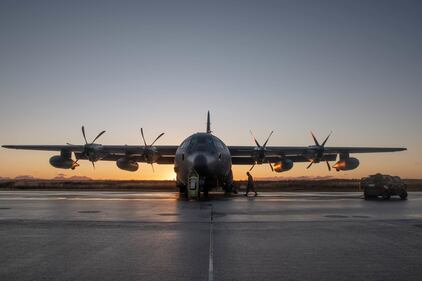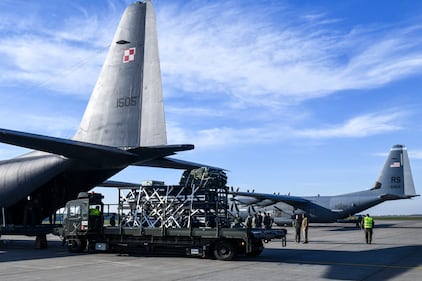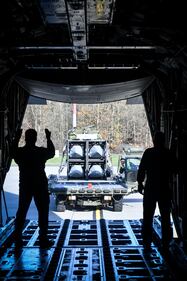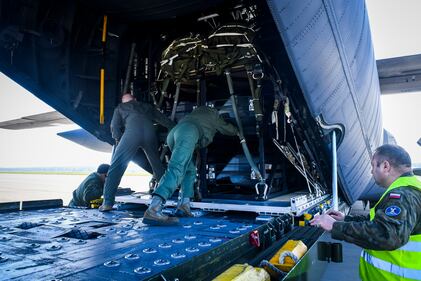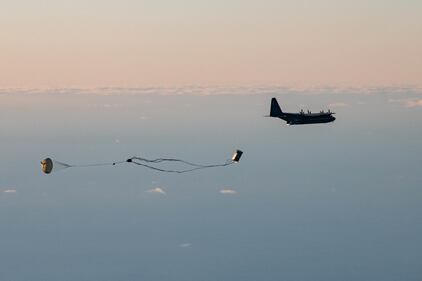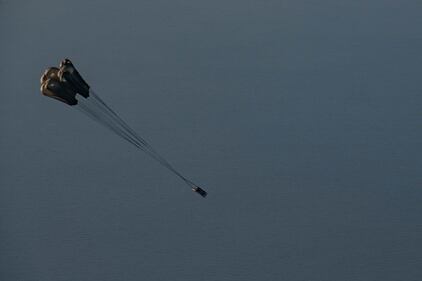WASHINGTON — The U.S. Air Force has for the first time in an overseas test used its Rapid Dragon system, in which cruise missiles on pallets are launched from the back of a mobility aircraft.
An MC-130J Commando II from the 352nd Special Operations Wing launched a Joint Air-to-Surface Standoff Missile-Extended Range cruise missile using the system nicknamed “bomb bay in a box” in a range over the Norwegian Sea on Wednesday, the Air Force Research Laboratory said.
Dean Evans, the program manager for Rapid Dragon, said the successful test shows how quickly the program is progressing, noting that it moved from a concept on paper to a live-fire test in two years.
“Now, less than three years from the program’s inception, Rapid Dragon is being used by [U.S. Special Operations Command Europe] in the Arctic Circle,” Evans said in a release. “This is a testament to the team’s focus on rapid fielding to meet warfighter needs.”
The command posted a video online Wednesday that shows the test process at Norway’s Andøya Space Defense Range from multiple perspectives. A parachute attached to the Rapid Dragon deployment box is tossed from the open cargo bay of the MC-130, which then unfurls and swiftly pulls the pallet out of the aircraft.
The hurtling box sheds its deployment parachute and deploys a quartet of other parachutes that steady it. When the deployment box is vertical, it releases a JASSM-ER missile downward. Within seconds, the missile’s wings and tail snap open, and its engine engages, leaving a trail of exhaust in its wake.
This was the first live-fire Rapid Dragon test since the Air Force destroyed a target in the Gulf of Mexico in December 2021, and the first time the concept was used outside of the continental United States, the Air Force Research Lab said.
A longer video of the test posted by the Pentagon showed the cruise missile traveling over the sea for about 2 minutes before detonating. When asked if a target was destroyed, the lab did not respond directly, but said that all objectives were met.
Image 0 of 6
Additional photographs posted by the Air Force showed American and Polish airmen training to load palletized munitions onto a Polish C-130. That training took place Tuesday in Powidz, Poland.
The lab said the program has so far focused on kinetic munitions, but is now turning its attention to adding “palletized effects.” Those effects include intelligence, surveillance and reconnaissance platforms, cargo resupply, and humanitarian aid delivery, the release said.
The Air Force hopes this concept will allow the U.S. and its allies to turn cargo aircraft into heavily armed bomb trucks that can engage enemies at a safe distance, giving combatant commanders more options to deliver firepower.
The lab said this test took place as part of U.S. European Command’s operational series Atreus, which aims to conduct training events on capabilities found in Europe. The 352nd Special Operations Wing is based at RAF Mildenhall in England, and the MC-130 was from the wing’s 67th Special Operations Squadron.
This test was the seventh Atreus event, and in addition to Norway also included allies from the United Kingdom, Poland, and Romania.
Previous Atreus training events focused on using the High Mobility Artillery Rocket System along with allies from Romania, the U.K., Sweden and Latvia.
Stephen Losey is the air warfare reporter for Defense News. He previously covered leadership and personnel issues at Air Force Times, and the Pentagon, special operations and air warfare at Military.com. He has traveled to the Middle East to cover U.S. Air Force operations.
